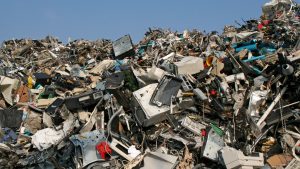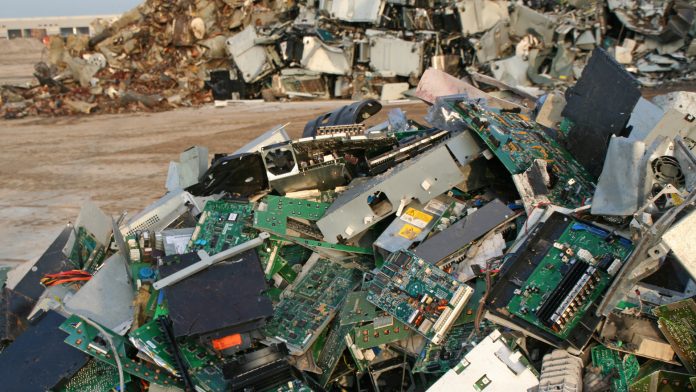A research team has developed a novel framework aimed at achieving a circular economy for electronic waste, a substantial objective in achieving a sustainable planet.
The new model, created by researchers at the Hypothetical Materials Lab at the University of Pittsburgh Swanson School of Engineering, expertly analyses difficulties in the recycling chain of electronics – one of the most considerable causes of pollution globally, in an effort to establish a circular economy for electronic waste.
Electronic waste (e-waste) has risen exponentially over the last few decades, with technology becoming increasingly pervasive in everyday life, from televisions and computers to smaller goods such as hairdryers and charging banks; when their life cycle comes to an end, where do they go? Unlike certain plastic and metal items that are often easy to repurpose, recycling increasingly complex electronics poses a more formidable challenge, which makes achieving a circular economy – a sustainable economic system that ensures materials are recycled, and waste is minimised – arduous.
Furthermore, even when sustainable recycling practices and legislation are implemented, ensuring that they are fulfilled still remains a problem, with various companies worldwide utilising dishonest recycling methods, such as landfilling or exporting to foreign countries to maintain the façade of a circular economy for electronic waste.
Christopher Wilmer, the William Kepler Whiteford Faculty Fellow and associate professor of chemical and petroleum engineering, who leads the Hypothetical Materials Lab, said: “Electronics have huge environmental impacts across their life cycle, from mining rare raw materials to the energy-intensive manufacturing, all the way to the complicated e-waste stream.
“A circular economy model is well-suited to mitigating each of these impacts, but less than 40 per cent of e-waste is currently estimated to be reused or recycled. If our technology is going to be sustainable, it’s important that we understand the barriers to e-waste recycling.”
The current landscape of a circular economy for electronic waste
Staggering statistics published by The Global E-waste Monitor – an annual report on the global impacts of electronic waste – indicates not only the monumental quest ahead to realising a circular economy for electronic waste but also the vast economic, environmental, and health benefits that could be achieved through attaining it.
They report that in 2019 alone, 53.6 million tonnes of electronic waste was generated – equating to 200 Eiffel towers – with only 17% of this being sustainably recycled, leaving 83% to be discarded irresponsibly into landfills and other means. This is estimated to rise to 74 million tonnes by 2030. The biggest perpetrator of E-waste was found to be smaller, daily used items such as vacuum cleaners and cameras, adding up to 17.4 million tonnes – ten million more than monitors and screens.

The effects of this hazardous have detrimental impacts on the health of the population and the planet also, with electronic waste depleting 50 million tonnes of precious mercury each year, in addition to causing what can be fatal health implications, as their toxins can be inhaled, ingested, and exposed to the skin, leading to brain damage and even death.
With regards to the environment, by not giving a new lease of life to precious raw materials such as copper, iron, and gold that are used in everyday devices, a huge economic opportunity is being squandered, with the E-waste stream amount equating to £44.8 million, recovering only £7.9 million of this. Despite there being policy, regulation, or legislation in place to ensure a circular economy for electronic waste covering 71% of the world’s population, there are still 117 countries without these policies, with illegal practices still being carried out in countries that have adopted them.
Examining the motivation for dishonest recycling
The Basel Action Network investigated the improper disposal of electronic goods between 2014 and 2016, placing GPS trackers in electronic waste delivered to US recyclers, discovering that 30% of these products were exported overseas. To tackle this problem, the researchers created a model framework that analyses the improper end-of-life management of electronics and the reasoning for recyclers carrying out fraudulent activities. They concluded that the principal way to ensure proper recycling practices are undertaken is to make the process more profitable, achieved through mitigating costs of the operation or increasing penalties for fraudulent activity.
Daniel Salmon, a graduate student in the Department of Electrical and Computer Engineering, said: “The main barrier to honest recycling is its cost. One of our main findings is that if we find a way to make it more profitable for companies to recycle, we will have less dishonest recycling. Targeted subsidies, higher penalties for fraud and manufacturers ensuring their electronics are more easily recyclable are all things that could potentially solve this problem.”
“Our model mentions the influence of monitoring and supervision, but self-reporting by companies enables dishonesty. On the other hand, something like the blockchain does not. Relying on an immutable record may be one solution to prevent fraud and align behaviours across recyclers toward a circular economy,” Wilmer commented.





